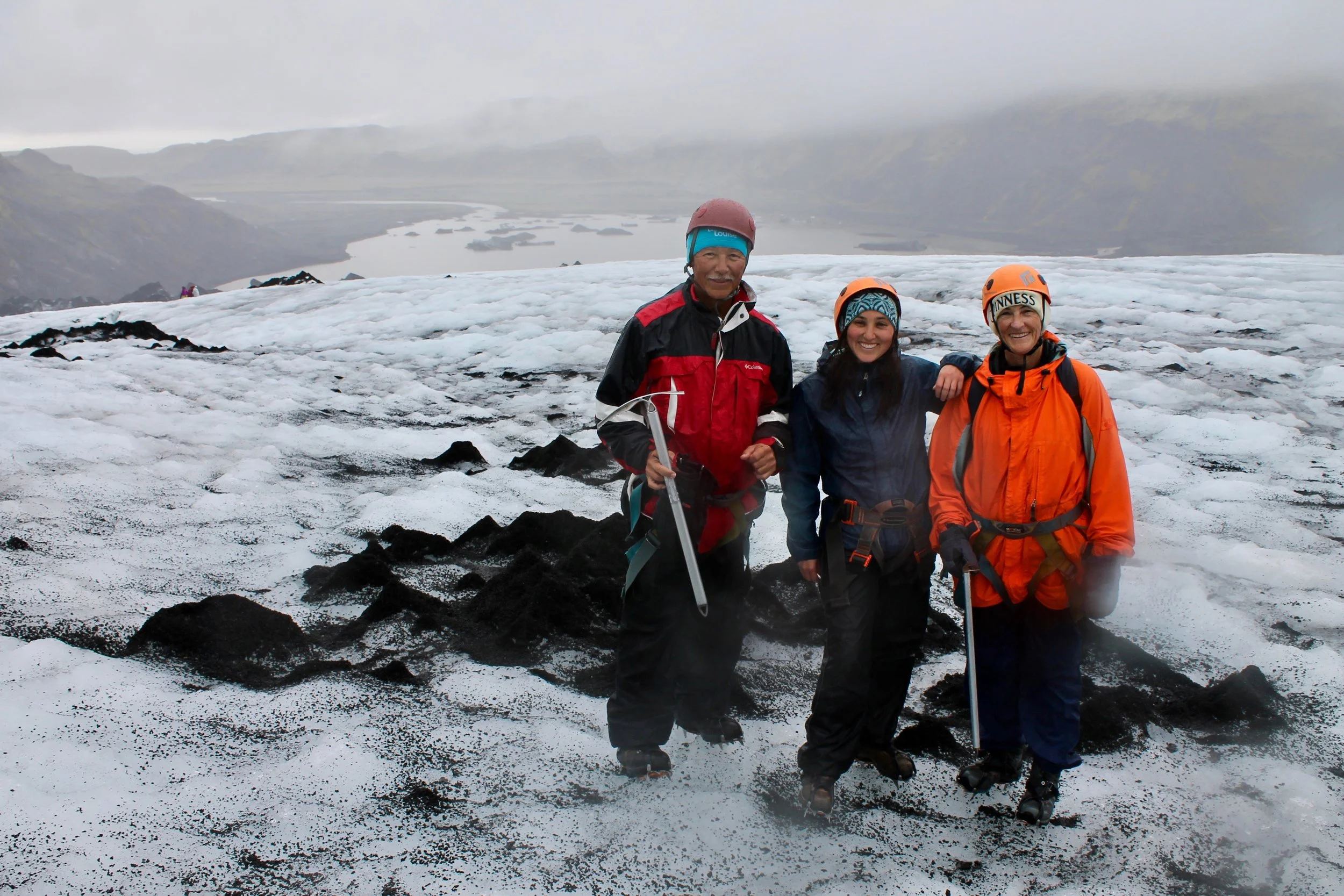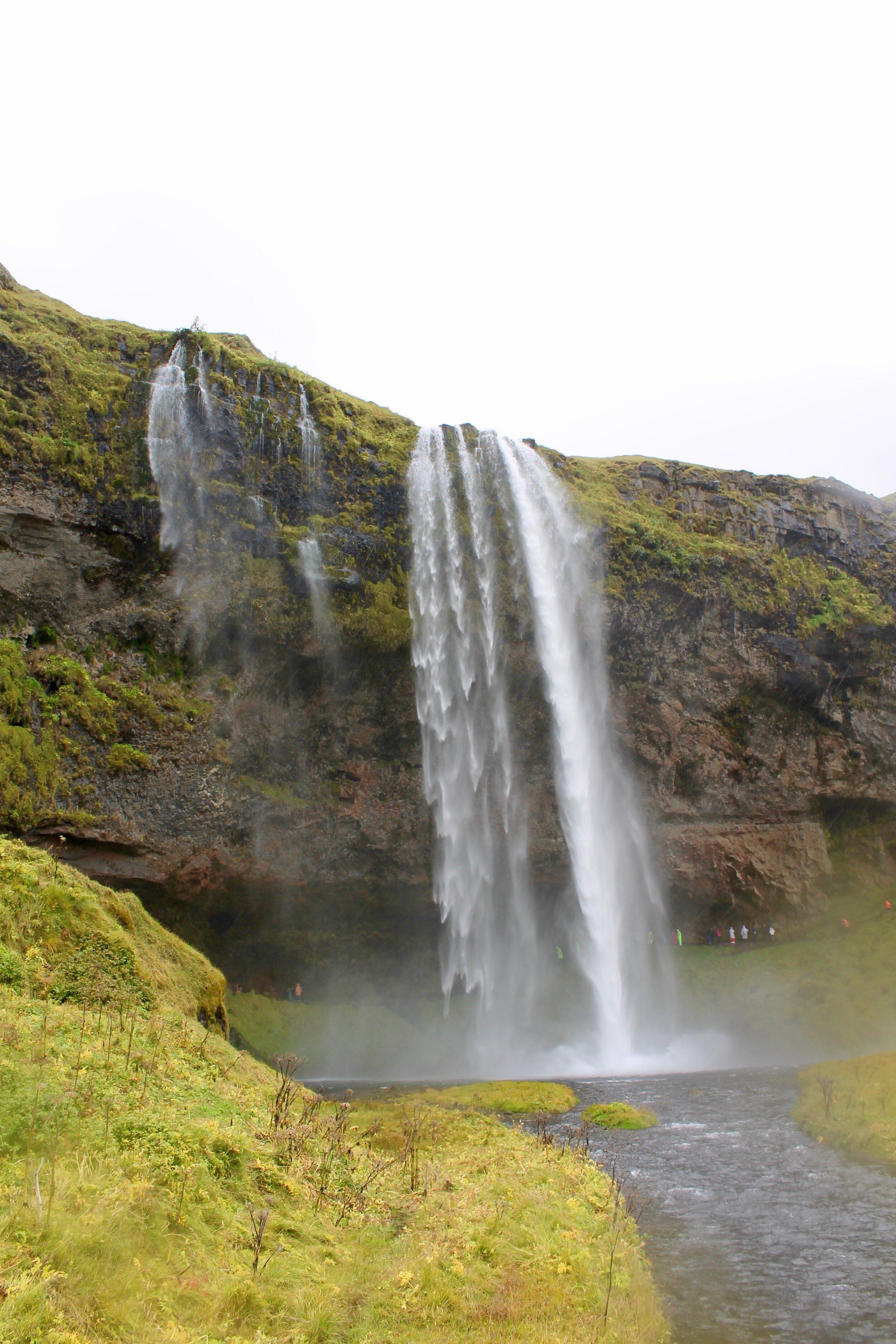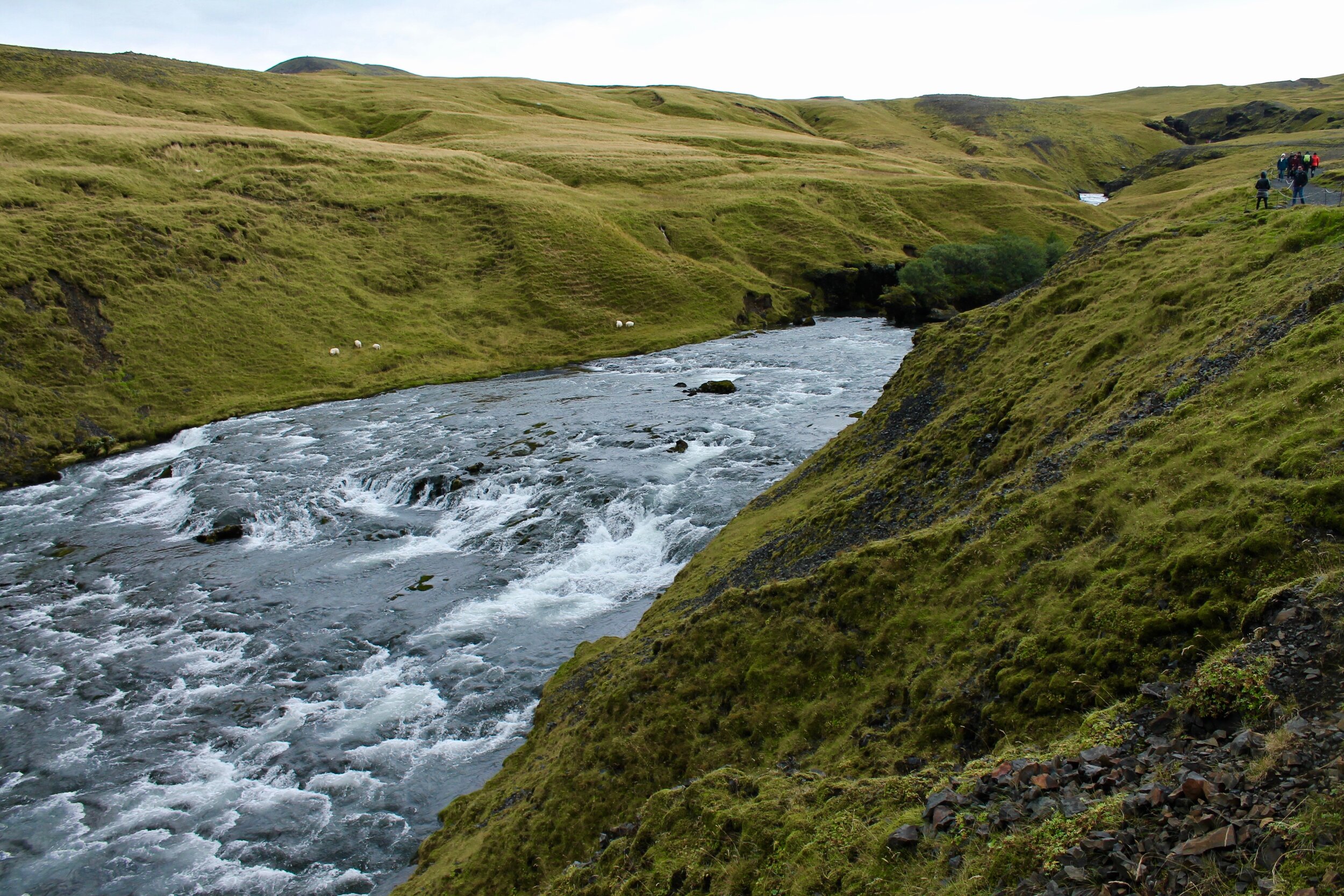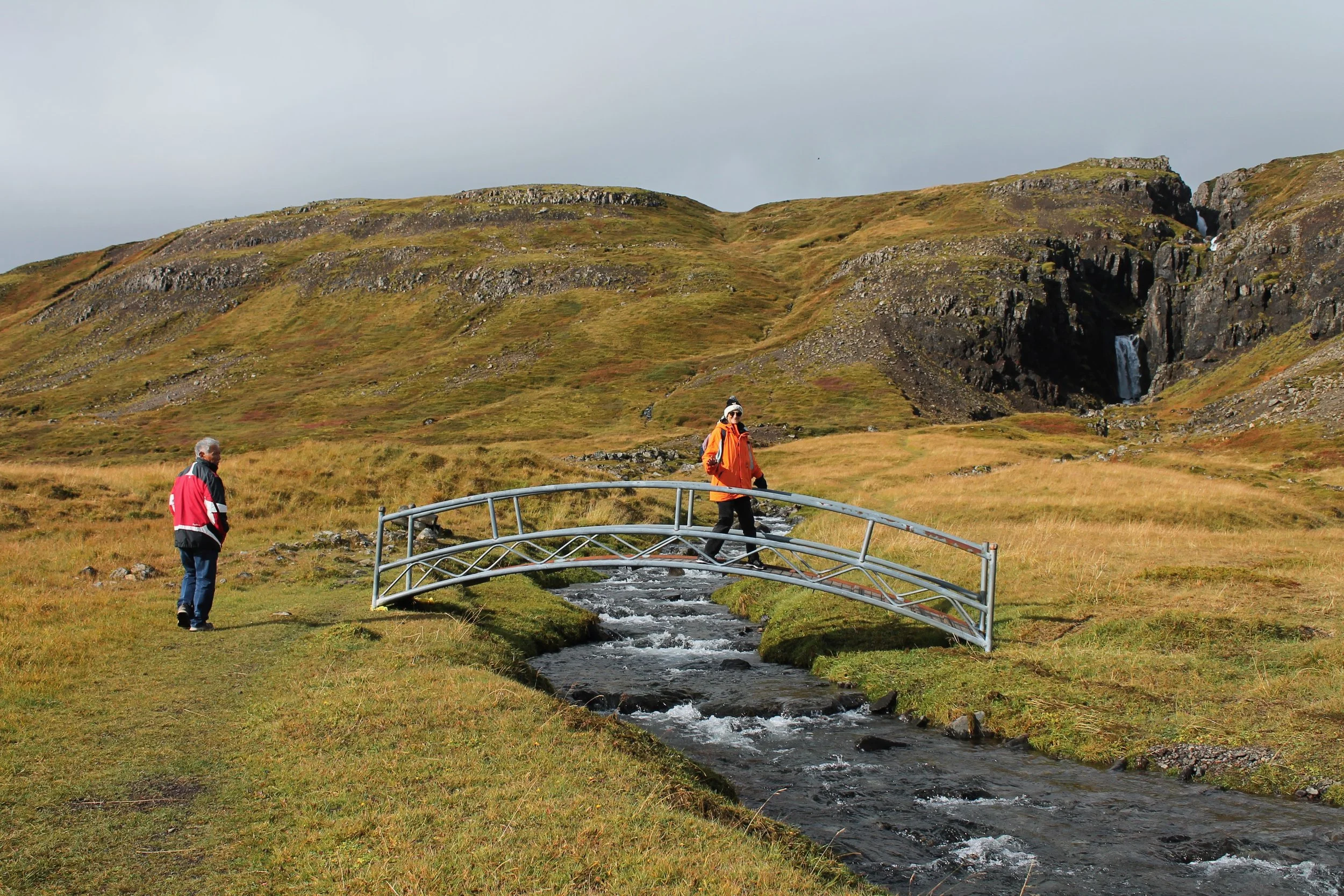Our Travels to Iceland: Day 4 South Coast Tour
One foot steps down hard in front of the other. My breath grows ragged as I stomp after the group, up the ice, praying that my crampons actually stick like they’re supposed to.
Today was our tour of the South Coast highlights of Iceland.
At 7:45 am, we walked out of our Airbnb apartment, turned left, walked across a parking lot and arrived at our bus stop (#1 City Hall). There, we tried to hide from the wind as we waited for our Arctic Adventures shuttle to arrive.
When it did, we were greeted by a white-haired man with a big smile. He informed us that we were the only ones getting on at our stop and helped us inside.
Once we were settled in our seats, we had a long drive south. As moss-covered lava fields and arching volcanic mountains slipped passed our windows, our driver provided us with little insights into the country and its impressive landscape, including the history of the Hekla volcano and Eyjafjallajökull. Eye-ya-fjalta-yo-katl. Try saying that six times fast. (I did).
And we continued on down the winding road until we got to a gas station where we promptly fled the bus to use the restroom and grab some much needed coffee.
Traveler’s note: One of my favorite parts about taking tours is picking up on the little mannerisms of the guides. I loved how our guide would end or start sentences with “of course,” like we were had previous knowledge of the obscure facts he continued to tell us. For example, he would say, “Hekla erupted in 2000. So, of course, it is ready for another eruption soon.” IS it? Believe me, sir. I had no clue that there was a ready-to-erupt volcano right in plain view.
South Coast Icelandic Waterfalls: Gljúfrabúi & Solheimajökullfoss
Back on the bus, we headed further south to two famous waterfalls: Gljúfrabúi (the hidden waterfall) and Solheimajökullfoss.
We parked in the far parking lot near Gljúfrabúi and I waited as my parents changed out of their sneakers and into the hiking boots that we’d rented. It’s a good thing that they did change into them. As we neared Gljúfrabúi, we saw that it was, indeed, hidden.
It was tucked away between boulders in just such a way that allowed you to hop across on stones that poked up from the stream beneath it. Holding onto the boulders, you could make your way into the hidden cavern that held the waterfall.
So, my mom and I grasped onto the stones and carefully made our way across and into the cave where the waterfall showered down.
At one point, we had to let people who were leaving the cavern pass by. Clinging to the rocks, we let them use our backpacks as leverage to get by. Then, with a push and jump, we made our way along to the Gljúfrabúi waterfall.
It was more than worth it.
Inside, it felt like a secret chamber. Not a freaky chamber of secrets like in Harry Potter. Something a lot more magical and mysterious and awe-inspiring. The water poured down in white sheets and crashed loudly against the rocks below.
After some time staring up at its powerful forces, we had to get a move on because—that’s the thing with tours, isn’t it?—you’re constantly on a time crunch!
Once out of the cavern, we found my dad and made our way down the black gravel path (made up of crunched lava rock) toward the next waterfall, Solheimajökullfoss.
Talk about a waterfall.
As a child, I remember daydreaming about one day living behind a waterfall. I imagined something akin to the Jetson’s futuristic house, only hidden away behind sheets of rushing water. Just call me the Frank Lloyd Wright of my generation.
Anyway, here, my dream became reality. Walking up the muddy path to the right of the waterfall, we not only came close enough to be deafened by the thunderous churn of water, but we actually walked right behind it! You can imagine the amount of photographs being taken and poses being held, but it still felt so incredible to be there. It was unlike anything I’d experienced before.
Then, we had to hurry up, climbing some large stones and then jogging down the path on the other side in order to make it to our bus on time.
South Coast Icelandic Waterfall: Skógafoss
Our next stop was another stunning waterfall, Skógafoss.
You would think that it’d get boring visiting one waterfall after another, but it didn’t. Each was its own spectacular form, crashing down into a different environment.
Here, we took on the challenge of walking the 427+ stairs to the lookout at the top. There, we stopped to admire the way the water dropped down from the cliff and rocks, crashing toward the stones below. We also took a moment to say hello to some sheep that were grazing on a nearby hill. They’d be brought into the farms soon, so it was nice to enjoy the last moments of summer with them.
Then, we raced down the stairs so that we could spend some time on the rocky sand-like landscape below. Birds soared across the gray sky, crying out in some unknown language as the rush of the water pummeled down and onto the land.
It truly is amazing to be so close to something so powerful.
And then it was time to head back to our bus.
South Coast Icelandic Black Sand Beach & Basalt Caves: Reynisfjara + Reynisdrangar
Our next stop was the Reynisfjara Black Sand Beach. However, as we moved away from the waterfalls and toward this next stop, it suddenly began to pour. I mean DUMP. Rain was falling as fast as it could toward our shuttle’s windshield.
The last time I was in Iceland, I had a tour guide named Finn. Whenever anything seemed particularly disturbing (like a tourist blatantly disregarding his advice and sticking a finger into the scalding geothermal pools), he’d simply accept the fact that this was how things go sometimes. “People are people,” he explained with a shrug.
I like to try to adopt this attitude as much as possible. So, as rain hurtled toward us and the wind blew fiercely, I accepted it and refused to let it get in the way of this experience. Weather is weather.
We ran from the shuttle into the Black Sand Restaurant where we ordered soup and sandwiches and sat down to wait out the storm. As we chewed on the bread and enjoyed the hot, spicy, turmeric-tasting soup and a thick veggie sandwich, we realized that—although the rain was letting up a little—it wouldn’t be letting up enough to feel comfy outside.
So, finishing our meal, we wrapped our jackets around ourselves and headed to the shore anyway. Rain pelted us, blown by the wind in a horizontal attack. The sea crashed and roared, but it was spectacular to watch.
Caves of basalt stood in front of us and we found shelter inside. Staring at the rock formations, it was incredible to witness these shapes and cutouts of the stone.
We visited both caves, admired the way the wild ocean swelled and crashed, and then made our way back to the bathrooms and, finally, the shuttle.
South Iceland Glacier: Solheimajökull
After a quick detour to Vík in order to kill some time before our glacier hike (since we’d spent a considerably shorter amount of time at the Reynisfjara Black Sand Beach than expected). We looked down from a lookout point and saw the same rock cliffs that were nearly hidden by clouds when we’d been on the black sandy shores moments ago.
And then, of course, it was time to move on. We drove for about 15 minutes to drop off our two excitable and personable Scottish (and Welsh actually) fellow travelers—who were opting to go off and look at a plane crash by the beach rather than climb some ice.
Then, we drove off through the rain to the base of Solheimajökull. There, we stopped in front of an old yellow school bus.
As I hopped out of our shuttle and into the bus, I heard raised voices. It seemed that our glacier guide was questioning another tour participant’s ability to do the hike. It felt uncomfortable in the confines of the bus and became even more so when the participant’s wife came inside—and started challenging the guide (not in a bad way but in a ‘I need to know more to make an informed decision’ sort of way).
After quite a bit of back and forth, it was decided that the couple would stay behind and the rest of us would trek up the mountain.
Of course, at this point, my mom starts wondering if she’s fit enough to make the journey herself. And, to be honest, I was wondering the same thing.
To make matters a bit more awkward, it seemed as though our guide was trying to overcompensate for the uncomfortable moment that had just occurred—and made some forced jokes and happy laughter.
However, after a few crampon fittings, the dialogue became natural—and we realized that our guide was genuinely funny.
With a helmet on and ice-pick/crampons in hand, we made our way to the base of the mountain. There, we came to a map where we stopped to look at the glacier and mountain that was pictured. Our guide pointed out the part of the glacier that we would be walking on.
It looked so tiny. Like the bottom portion of your pinky finger. However, he explained how the scale of the map actually worked—and our little hike suddenly seemed a lot bigger.
That’s when the nerves kicked in.
But, before they could really get in the way, we were on our way across the ashy sands and along a little lagoon where icebergs floated.
We walked in a single file line with no gaps between any of us because of Keith Richards. Yes, the leading member of the Rolling Stones kept us in line.
Okay, so we weren’t actually going to meet any rock stars on this trip. Keith Richards is the name of a literal rolling stone. This fallen boulder was named after the famous star because 1. It had just as many lines on its surface and 2. Because it was just as adventurous as the rock star—and could get you into just as much trouble.
Basically, you walk in a straight line because if a boulder does start to roll down toward you, it’s easier to get out of the way. #safetyfirst
After stopping and learning how to put on our crampons—wedging our heels between the back portion, closing the toe grip, winding the tether through the toe hold, through the back loop, over the laces, and through the clasp—we made our way to the base of the glacier itself.
One step in front of the other, we climb up ice stairs and into a sea of ash-covered snow.
I’ve always put my head down when I walk. I like to know where I’m stepping. Maybe it’s from all of these years living in San Francisco. There’s nothing worse than looking up and stepping into human feces. Too gross? Well, that’s my reality.
Anyway, concentrating on keeping my shoulders back and eyes straight ahead, I climbed after our group up and over the chunks of ice.
At one point, my breathing quickened and I felt my legs ache a bit as I lifted one foot and placed it down just slightly in front of the other.
My mom was obviously feeling the same way as a gap began to form between her and the person in front of her.
Still, I thought to myself, how fucking impressive is it that both my parents are in their sixties and are on this hike with me and other 20-30 year olds.
Our guide was impressed too.
He kept exclaiming how well our group was doing and even told us that he was going to take us much further than expected. We crossed into the heart of the glacier and witnessed ice climbing. A novice and her guide descended (or tried to descend) into a ‘moulin’—or little cavern in the ice.
Of course, I’m not sure if I believe what our guide said about our endurance and skill level. I’m pretty sure we were an average bunch. However, I love how much he loved my parents and how excited he was that they were on the tour. He constantly checked on my mom and freely admitted that she was his favorite.
At one point, he stuck two of our ice picks into the ice and then showed us how to do a push up (or at least hold chest up) in order to drink from the stream of water that trickled down. I failed at the push up part, but my dad killed it.
“Wow!” said our guide, “that is a great physique!!”
From the heart of the glacier, we could look out into the lagoon, down on the icebergs that floated by. It was peaceful, quiet, and serene.
It was even more special when I thought about how one day this glacier would be gone. And that day is sooner than we think. There’s a sign down below, on the black lava sand, that shows where the iceberg came to in 2010. It’s far from where the receded ice can be found today.
Making our way back down, we walked quickly over the blue and white ice, observed another ‘moulin,’ and then made our descent.
During the descent, another group was coming up. Out of the corner of my eye, I saw a familiar face. I must have gawked and stared open mouthed because the man looked up and grinned. It was one of my favorite Icelandic photographers, Benjamin Hardman. I’ve followed his Instagram and YouTube for more than two years now and love everything he posts. So, in my eyes, he’s something of a celebrity.
And there he was. Right in front of me on my trip to Iceland. Incredible!
At the bottom of the glacier, back on the lava shores, we stood in a circle and undid our crampons. Our guide took photos of us in front of the glacier and took a moment to explain what he loved most about living in Iceland (he’s originally from Croatia).
Apart from the fact that for people like him, mountaineers, it was like an endless playground, he explained that there was something incredible about the attitudes of the people as well as the efficiency of the country.
“Þetta reddast,” he said, “it means that it will all be okay. They are so calm here. They don’t sweat the small stuff. And, yet, somehow the country is so efficient. It’s like the best of both worlds. It’s got the efficiency of Scandinavian countries, but the laid back attitude that others don’t have.”
Walking back to the bus, we made a quick bathroom stop. Then we bid farewell to our glacier hiking guide and enjoyed each other’s conversation (learning a bit about Scotland from our shuttle companions and planning a future trip there) during the long drive back to Reykjavík.
Once back in town, we checked on the car and then went out in search of some good fish to eat.
Reykjavík Fish Restaurant: Fiskfélagi∂
Boy, did Fiskfélagi∂ deliver. Not only was the food incredible, but the service was so friendly as well. A young man with a beard came up to us shortly after our server had left and presented us with a live-edge charger topped with little ceramic bowls which each had a mixture of herbs, herring, and a seasoned mayonnaise.
“You have been chosen!” he exclaimed as he set them down, “these are appetizers or… where do you come from?”
“Hawaii,” we replied.
“Oh, dear,” he answered, “I do not know the word for it in Hawaiian.”
“Pu-pus,” I quickly delivered, then giggled because it is, of course, a strange word for delicious bites of food.
He looked at me like I was crazy.
“Poo-poo-s,” he asked.
I nodded.
“Okay,” he said, shaking his head and laughing to himself, “here are your poo-poos.”
We spooned the concoction onto slices of fresh bread and washed it down with locally brewed beer Rökkr, an Einstöck White Ale, and a Viking porter.
Each of our meals were incredible: a mediterranean style wolfish for my mom, sushi and pork belly for my dad, and miso-glazed salmon for myself.
It was the perfect end to an exhaustingly satisfying day.
Here’s to day five!















































